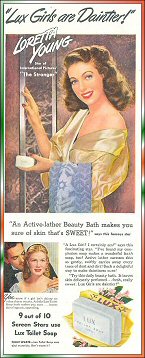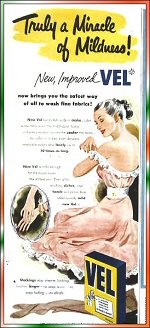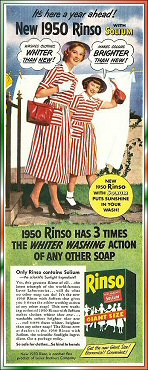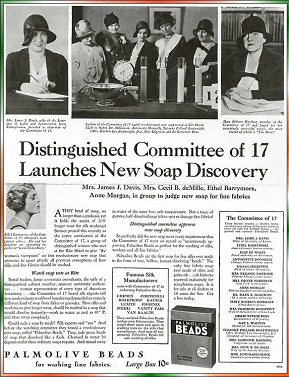Radio Advertising�..
The Unusual, The Bizarre
"Sparkling�.. uh, uh,
sparkling, uh��.
what�s the name?"
--- Harry Von Zell
Lincoln, Me. (DG)---
 With the title of this article, you might suspect more commercial
bloopers. Not this time. These commercials went on the air without any
misplaced or mispronounced words--- but there was still something a little
out of the ordinary about them. With the title of this article, you might suspect more commercial
bloopers. Not this time. These commercials went on the air without any
misplaced or mispronounced words--- but there was still something a little
out of the ordinary about them.
The first feature concerns the Columbia Network serial
program THE LIFE & LOVE OF DR. SUSAN. The program was on the
air for less than a year. Although the program was on the air for a short time,
the way the commercials were presented would be considered unique. On other
programs, the qualifications to become a topnotch radio announcer consisted
of a good speaking voice and had to speak enthusiastically about the product
he/she was selling. In order to become the announcer on the Dr. Susan program,
he/she also had to display an exceptional singing voice for the musical commercials
of the program�s sponsor, Lux Toilet Soap. The announcing position
on the program belonged to Frank Luther  . He was qualified to do the job, because he was
a famous radio singer during the 1930�s. He used his musical talents in
making the commercials for Lux Toilet Soap memorable. . He was qualified to do the job, because he was
a famous radio singer during the 1930�s. He used his musical talents in
making the commercials for Lux Toilet Soap memorable.
Fred Allen�s famous "Eagle Show" was a situation
where announcer Harry Von Zell used some clever ad-libbing in his
presentation for a commercial. With "Mr. Ramshaw" the eagle
loose in the studio, there was considerable chaos. With the commotion
going on, it was time for Von Zell to present the commercial for Sal
Hepatica. Instead of the usual "Smile Of Health" type
commercial Sal Hepatica was famous for, Von Zell and Allen
used Mr. Ramshaw to ad-lib a humorous commercial. To start things
off, Von Zell pretended to be upset with the eagle at large. He began the
commercial without any problem, but when it was time to mention Sal
Hepatica, he forgot the product�s name. Allen tried to help him,
but Von Zell couldn�t come up with Sal Hepatica. He did
remember all the good things the product did for the typical human--- but
the product�s name escaped him for the moment. With Von Zell�s
apparent memory lapse, Allen asked the studio audience to yell out the
product the announcer was talking about. Von Zell�s memory came back to
him when he heard the studio audience yell out Sal Hepatica.
 As you already know, Lava was famous on the radio for the
deep voice "singing" "L-A-V-A
L-A-V-A!" Whether or not it was considered a jingle is a
matter for debate. If it was, it would be considered the shortest jingle. With that in mind, when it comes to the shortest jingle using more
than one word, Vel was the definite winner. As you already know, Lava was famous on the radio for the
deep voice "singing" "L-A-V-A
L-A-V-A!" Whether or not it was considered a jingle is a
matter for debate. If it was, it would be considered the shortest jingle. With that in mind, when it comes to the shortest jingle using more
than one word, Vel was the definite winner.
Vel made history as Colgate-Palmolive-Peet�s
first synthetic detergent. It was tailor made for washing dishes, fine fabrics,
and milking equipment on farms. It was so popular, Vel was
made with the saving of money in mind. Each yellow Vel box held
25% more detergent than the competition. Although it was generous with the product
content, Vel was stingy with its musical jingle--- which was another
plus with those radio listeners who hated radio jingles. It consisted of only
3 words, "It�s Mar-VEL-ous�.. V-E-L!" The jingle was brief, to the point, and the listeners were returning
to the program they were listening to. The jingle was brief, to the point, and the listeners were returning
to the program they were listening to.
With today�s sports terminology, the word "defense"
is pronounced differently from everyday life. As you already know, it�s
pronounced "DEE-fense." If you noticed the Vel
jingle closely, "marvelous" is pronounced in a different
manner than what we're
 used to. It just so happens, the product�s name
consisted of the middle 3 letters. Since the product was named Vel,
it made sense to split the word up into 3 syllables, and to accent the
"vel." used to. It just so happens, the product�s name
consisted of the middle 3 letters. Since the product was named Vel,
it made sense to split the word up into 3 syllables, and to accent the
"vel."
Listeners who tuned in to the AMOS �n ANDY SHOW
heard announcer Ken Carpenter talk about "The New 1950 Rinso." It was the best Rinso ever made. It had 3 times
the whiter washing action of any soap brand on the market. The laundry washed
in New1950 Rinso was whiter and brighter than when it was new. It was the product that puts sunshine in the wash (if only Rinso
could do that for the weather). It was the best Rinso ever made. It had 3 times
the whiter washing action of any soap brand on the market. The laundry washed
in New1950 Rinso was whiter and brighter than when it was new. It was the product that puts sunshine in the wash (if only Rinso
could do that for the weather).
What I have written here doesn�t sound much out of the ordinary, does
it? There is definitely something unusual about the commercial. Carpenter
described the New 1950 Rinso on a 1949 AMOS
�n ANDY SHOW broadcast! As he stated, the New 1950 Rinso
was a year ahead. It�s obvious that Lever Brothers, who
made Rinso, wanted their product available to the public
A.S.A.P. Personally, I don�t blame Lever Brothers for
getting the New Rinso out to the public--- but why not call
it New 1949 Rinso!?
 We all know about Cheerios, the famous ready to eat cereal.
The tasty little "O�s" have been a part of breakfast
for many years. If you�re not familiar how Cheerios began,
this might surprise you (I admit, it surprised me when I first learned how
it). We all know about Cheerios, the famous ready to eat cereal.
The tasty little "O�s" have been a part of breakfast
for many years. If you�re not familiar how Cheerios began,
this might surprise you (I admit, it surprised me when I first learned how
it).
On a 1944 broadcast of VALIANT LADY, I assumed announcer
Dwight Weist said Cheerios sponsored the program. In reality,
he didn�t--- at least with that brand name!  During the early 1940�s, Cheerios was originally known
as Cheerioats. It was also slightly different from the Cheerios
we know of today. Cheerioats was the oat cereal that was also
flavored with added corn and rye. It was the perfect breakfast for the "Fighters
On The Home Front." During the early 1940�s, Cheerios was originally known
as Cheerioats. It was also slightly different from the Cheerios
we know of today. Cheerioats was the oat cereal that was also
flavored with added corn and rye. It was the perfect breakfast for the "Fighters
On The Home Front."
Cheerioats got into some trouble with its name. The
"oats" part of the name was closely associated with another
company who was famous for its hot oatmeal cereal. General Mills
simply dropped the "at" and renamed its product Cheerios.
Despite the name change, Cheerios continued to be a popular
breakfast cereal.
 Finally, this advertising promotion took place in 1931. The product in
question was Palmolive Beads, a brand new bead soap for fine
fabrics. It was made with the same palm and olive oils Palmolive
Soap made famous during that time. * Finally, this advertising promotion took place in 1931. The product in
question was Palmolive Beads, a brand new bead soap for fine
fabrics. It was made with the same palm and olive oils Palmolive
Soap made famous during that time. *
In order to get the new product off the ground, it was tested with
other soap brands for instant dissolving, speed rinsing, and for cleaning
in cool water. To judge the test, "The Committee of 17"
monitored the proceedings. The Committee of 17 consisted of 17 of America�s
most distinguished women of 1931. In a unanimous vote, all 17 members were
impressed with Palmolive Beads. In a note of interest, one
member of the Committee of 17 was Eleanor Roosevelt, who was listed in the
enclosed ad as the
wife of the governor of New York. Of course, she and her husband went
on to bigger and better things the following year.
Since radio programs had their share of unusual and bizarre moments, it
was only fair that radio advertising also had its share. We�ll take a
look at more unusual and bizarre radio commercials in future
articles.
|